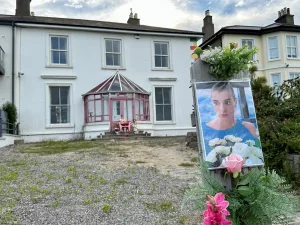
As most alert readers (ARs) know, 11,500 members of The Writers Guild of America have been on strike against The Alliance of Motion Picture and Television Producers since early May. While the viewing public awaits a resolution of this dispute and a resumed flow of fresh material from Hollywood, some ARs might be interested in revisiting some older stories that were around long before the advent of movies or TV.
Consider the legend of St. James The Great, who was the second of The Twelve Apostles to die (after Judas Iscariot) and the first to be martyred, when he was beheaded in Jerusalem in 44 AD by King Herod Agrippa. His headless body was then transported to Galicia, in what is now northwest Spain. Eight centuries later his remains were discovered at Compostela, inspiring the founding of the city of Santiago (St. James). By the time of the Middle Ages pilgrims had begun trekking on The Camino de Santiago de Compostela from multiple places in Europe. They were often accompanied by pickpockets, prostitutes and others seeking to profit from the pilgrimage.
In early August my wife and I set out on El Camino Portugues from Porto, which is renowned for its dozens of producers of port. While we walked enough of the Camino every day to work up an appetite for local cuisine and a thirst for local wines, we also traveled much of the route in vans and stayed in comfortable hotels. On the final day of our Camino we walked the last few miles to the Cathedral in Santiago, where I was surprised to hear the unmistakable sound of a bagpipe playing in the plaza. I am not making this up. It sounded like Burns Night at The Schlafly Tap Room. I then remembered that the music of Galicia owes its roots to the ancient Celtic traditions of the region, which predate the conquests by Rome and Spain and have endured to today.
From the Cathedral we went back to our hotel, where we showered and changed before boarding an Aer Lingus flight to Dublin, on which we witnessed a scene that could have been written by striking members of The Writers Guild. It reminded me of the 1980 movie Airplane or some of the best Monty Python skits. It confirmed the cliché that reality can often be more bizarre than fiction.

Sinead O’Connor’s House
We were seated in an exit row across the aisle from two Spanish gentlemen, one of whom spoke no English at all and one whose English was about as good as my Spanish, meaning not that bueno. When the Irish flight attendant explained the requirements of sitting in an exit row, one of the men replied in Spanish that he didn’t understand her. She then replied in English that he would have to relocate to another seat because understanding English was one of the requirements of sitting where he was seated. He replied heatedly in Spanish to the effect that he didn’t understand a word she was saying and wasn’t going anywhere. Their voices rose as she insisted that because he didn’t understand her he would have to move; and he insisted that because he didn’t understand why he needed to move, he refused to do so. The farce finally ended when the Spaniard who was minimally fluent in English was able to explain to his seatmate that if he didn’t voluntarily move to another seat he would be involuntarily removed from the flight altogether and possibly handed over to the Spanish criminal justice system.
After takeoff I was offered a choice of a bottle of water for three euros or a can of beer for six euros. Interestingly, neither of the beers was from Spain, the country from which we were taking off, or Ireland, our destination. The only options were Heineken and Moretti, respectively from Holland and Italy. Because I was seated in an exit row, I dared not ask for either one in Dutch or Italian.
While traveling in Ireland we happened upon the former home of the late Sinead O’Connor in the town of Bray, just south of Dublin. I reflected on the disparate influences on her music that ranged from Bob Dylan to reggae to Celtic ballads and bagpipes… like what I had heard a few days earlier in the plaza of the Cathedral in Santiago.
On our final day in Dublin I toured the iconic Guinness Brewery, which had been founded in 1769. To clarify, what I in fact toured along with thousands of other visitors that day was The Guinness Storehouse, where beer had last been brewed in 1988, three years before The Schlafly Tap Room opened for business. The tour included interesting exhibits and videos; various artifacts and memorabilia; and a tasting on the top floor in a room with spectacular views of Dublin. Unlike the Schlafly tours, visitors could not actually see beer being brewed or packaged. Also, the tour did not emphasize that ever since 1997 Guinness has been owned by a British multinational company called Diageo, which owns dozens of other brands, including Captain Morgan Rum and Jose Cuervo Tequila.
Some ARs probably know that The Guinness Storehouse is located at St. James Gate, which was named for the 12th century church and parish of St. James. It was the western entrance to the City of Dublin in the Middle Ages and is still the starting point of the Celtic route to El Camino Ingles de Santiago de Compostela. In other words, my personal Camino started with port in Porto and concluded with Guinness in Dublin.

Tom Schlafly
Chairman – The Saint Louis Brewery
